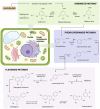Antioxidant, Anti-Inflammatory and Cytotoxic Activity of Phenolic Compound Family Extracted from Raspberries (Rubus idaeus): A General Review
- PMID: 35740089
- PMCID: PMC9230908
- DOI: 10.3390/antiox11061192
Antioxidant, Anti-Inflammatory and Cytotoxic Activity of Phenolic Compound Family Extracted from Raspberries (Rubus idaeus): A General Review
Abstract
Raspberries (Rubus idaeus) possess a wide phenolic family profile; this serves the role of self-protection for the plant. Interest in these compounds have significantly increased, since they have been classified as nutraceuticals due to the positive health effects provided to consumers. Extensive chemical, in vitro and in vivo studies have been performed to prove and validate these benefits and their possible applications as an aid when treating several chronic degenerative diseases, characterized by oxidative stress and an inflammatory response. While many diseases could be co-adjuvanted by the intake of these phenolic compounds, this review will mainly discuss their effects on cancer. Anthocyanins and ellagitannins are known to provide a major antioxidant capacity in raspberries. The aim of this review is to summarize the current knowledge concerning the phenolic compound family of raspberries, and topics discussed include their characterization, biosynthesis, bioavailability, cytotoxicity, antioxidant and anti-inflammatory activities.
Keywords: anti-inflammatory activity; antioxidant activity; cytotoxicity; phenolic compounds; raspberry.
Conflict of interest statement
The authors declare no conflict of interest.
Figures



Similar articles
-
Antioxidant activity of isolated ellagitannins from red raspberries and cloudberries.J Agric Food Chem. 2012 Feb 8;60(5):1167-74. doi: 10.1021/jf203431g. Epub 2012 Jan 27. J Agric Food Chem. 2012. PMID: 22229937
-
Quality, Bioactive Compounds, Antioxidant Capacity, and Enzymes of Raspberries at Different Maturity Stages, Effects of Organic vs. Conventional Fertilization.Foods. 2021 Apr 27;10(5):953. doi: 10.3390/foods10050953. Foods. 2021. PMID: 33925426 Free PMC article.
-
An exploratory study of red raspberry (Rubus idaeus L.) (poly)phenols/metabolites in human biological samples.Food Funct. 2018 Feb 21;9(2):806-818. doi: 10.1039/c7fo00893g. Food Funct. 2018. PMID: 29344587
-
Red Raspberries and Their Bioactive Polyphenols: Cardiometabolic and Neuronal Health Links.Adv Nutr. 2016 Jan 15;7(1):44-65. doi: 10.3945/an.115.009639. Print 2016 Jan. Adv Nutr. 2016. PMID: 26773014 Free PMC article. Review.
-
Red Raspberry (Rubus idaeus L.) Seed Oil: A Review.Plants (Basel). 2021 May 9;10(5):944. doi: 10.3390/plants10050944. Plants (Basel). 2021. PMID: 34065144 Free PMC article. Review.
Cited by
-
Emerging Role of Plant-Based Bioactive Compounds as Therapeutics in Parkinson's Disease.Molecules. 2023 Nov 14;28(22):7588. doi: 10.3390/molecules28227588. Molecules. 2023. PMID: 38005310 Free PMC article. Review.
-
Therapeutic efficacy of Citrus aurantifolia (lime) juice in experimental Eimeria tenella-infected broiler chickens.Trop Anim Health Prod. 2023 Dec 11;56(1):8. doi: 10.1007/s11250-023-03840-9. Trop Anim Health Prod. 2023. PMID: 38072881
-
Rubus urticifolius Compounds with Antioxidant Activity, and Inhibition Potential against Tyrosinase, Melanin, Hyaluronidase, Elastase, and Collagenase.Pharmaceuticals (Basel). 2024 Jul 13;17(7):937. doi: 10.3390/ph17070937. Pharmaceuticals (Basel). 2024. PMID: 39065787 Free PMC article.
-
Dose-Related Regulatory Effect of Raspberry Polyphenolic Extract on Cecal Microbiota Activity, Lipid Metabolism and Inflammation in Rats Fed a Diet Rich in Saturated Fats.Nutrients. 2023 Jan 10;15(2):354. doi: 10.3390/nu15020354. Nutrients. 2023. PMID: 36678224 Free PMC article.
-
Evaluation of the Content of Micro- and Macroelements in Raspberries Depending on the Species, Cultivar Variety, and Geographical Environment.Nutrients. 2023 Aug 30;15(17):3782. doi: 10.3390/nu15173782. Nutrients. 2023. PMID: 37686814 Free PMC article.
References
-
- Hummer K.E. Rubus pharmacology: Antiquity to the present. HortScience. 2010;45:1587–1591. doi: 10.21273/HORTSCI.45.11.1587. - DOI
-
- Gomes M.D.S., Cardoso M.D.G., Guimarães A.C.G., Guerreiro A.C., Gago C.M.L., Vilas Boas E.V.D.B., Dias C.M.B., Manhita A.C.C., Faleiro M.L., Miguel M.G.C., et al. Effect of edible coatings with essential oils on the quality of red raspberries over shelf-life. J. Sci. Food Agric. 2017;97:929–938. doi: 10.1002/jsfa.7817. - DOI - PubMed
-
- Brodowska A. Raspberry pomace—Composition, properties and application. Eur. J. Biol. Res. 2017;7:86–96. doi: 10.5281/zenodo.495190. - DOI
Publication types
Grants and funding
LinkOut - more resources
Full Text Sources

